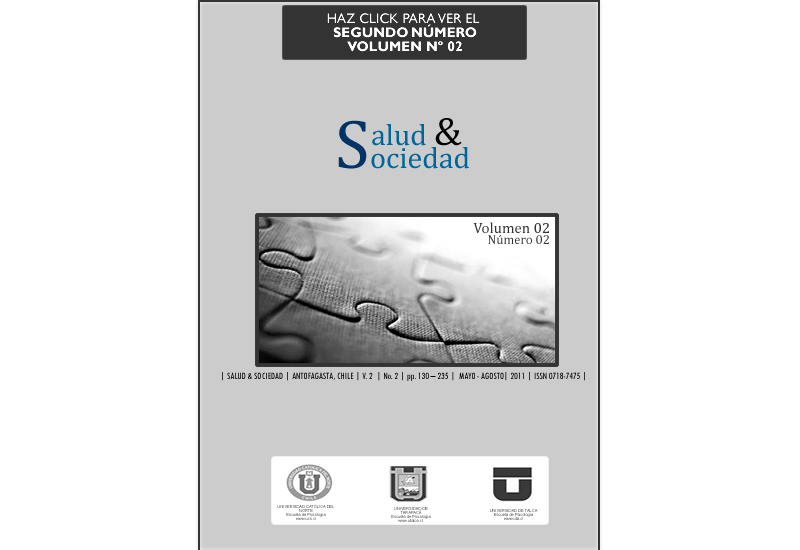Ingreso familiar y variables psicológicas asociadas a la pobreza como predictores de la calidad de la representación del apego en niños preescolares en Chile
DOI:
https://doi.org/10.22199/S07187475.2011.0002.00004Palavras-chave:
Ingreso familiar, depresión, estrés, representación del apego, pobreza, Household income, depression, stress, attachment representation, poverty,Resumo
El objetivo de este estudio es proponer un modelo predictor que permita identificar la vía por la cual el ingreso puede afectar la calidad de las representaciones de apego infantil a través de su efecto en variables psicológicas en los padres. La muestra está compuesta por 42 familias de nivel socioeconómico bajo, medio y alto. Se evaluó el ingreso familiar mensual por persona, el nivel de preocupación financiera, el nivel de depresión y estrés de los padres, y la calidad de la representación del apego en los hijos mayores de cada familia. Para analizar la relación entre las variables se realizaron regresiones lineales simples y múltiples. Los resultados señalan que el ingreso predice la calidad del apego infantil a través del nivel de preocupación financiera y de depresión de la madre, afectando el nivel de estrés de ésta. Estos hallazgos son discutidos desde la teoría del apego y la literatura que estudia el efecto de la pobreza en el desarrollo infantil.
The aim of this study is to propose a predictive model to identify the means by which income can affect the quality of infant attachment representations through its effect on parental psychological variables. The sample consists of 42 families of low socioeconomic status, medium and high. We evaluated the monthly family income per person, the level
of financial worry, the level of depression and stress of parents, and the quality of the representation of attachment in first born children of each family. To explore the relationship between variables simple and multiple linear regressions was performed. The results show that the income predicts the quality of infant attachment through the mother's financial worries and level of depression affecting her level of stress. These findings are discussed from attachment theory and the literature on the effect of poverty on child development.
Referências
Psychology, 40, 204-216.
Blehar, M. C., Lieberman, A. F. &, Salter Ainsworth, M. D. (1977). Early face-to-face interaction and its relation to later infantmother attachment. Child Development, 48, 182-194.
Bowby, J. (1969/1998). El apego y la pérdida vol 1: El apego. Barcelona: Paidós.
Bowlby, J. (1980/1993). El apego y la pérdida vol 3: La pérdida. Barcelona: Paidós.
Belsky, J. & R. M. Pasco Fearon, (2008). Precursors of attachment security. En J. Cassidy & P.R. Shaver (Eds.). Handbook of Attachment: Theory, research, and clinical applications (2ºed), (pp. 295-316). New York: Guilford Press.
Bretherton, I., Ridgeway, D., & Cassidy, J. (1990). Assessing internal working models of the attachment relationships: an attachment story completion task for 3-year olds. En M.T. Greenberg, D. Cicchetti &
E.M. Cummings (Eds.), Attachment in the preschool years, theory, research, and intervention, (pp. 273-310). Chicago: The University of Chicago Press.
Bridges, L. J., Connell, J. P., & Belsky, J. (1988). Similarities and differences in infant-mother and infant-father interaction in the strange
situation: a component process analysis. Developmental Psychology, 24, 92-100.
Bronfenbrenner, U., & Ceci, S.J. (1994). Naturenurture reconceptualized in developmental perspective: a bioecological model.Psychological Review, 101, 568-586.
Bronfenbrenner, U., & Morris, P. (1998). The ecology of developmental processes. En W. Damon & R. Lerner (Eds.), Handbook of child psychology, vol. 3: theoretical models of human development, (pp. 993- 1028). U.S.A. : John Wiley & Sons.
Brooks-Gunn, J., Duncan, G.J., Kato Klebanov, P., & Sealand, N. (1993). Do neighbourhood influence child and adolescent development? American Journal of Sociology, 99, 353-395.
Bruniaux, C., & Galtier, B. (2003). L’étude du devenir des enfants de familles défavorisées : l’apport des expériences américaine et britannique. Les Papiers du CERC, nº2003-1.
Cicchetti, D., & Barnett, D. (1991). Attachment organization in maltreated preschoolers. Development and Psychopathology, 3, 397–411.
Cohen, S., Kamarck, T., & Mermelstein, R. (1983). A global measure of perceived stress. Journal of Health and Social Behavior, 24, 385-396.
Conger, R. D., Conger, K. J., & Elder, G. H. (1997). Family economic hardship and adolescent adjustement: mediating and moderating processes. En G.J. Duncan & J. Brooks-Gunn (Eds.), Consequences of
growing up poor, (pp. 288-310). New York: Russell Sage Foundation.
Conger, R. D., Conger, K. J., Elder, G. H., Lorenz, F. O., Simons, R .L., & Whitbeck, L. B. (1992). A family process model of economic hardship and adjustement of early adolescent boys. Child Development, 63, 526-541.
Conger, R. D., Wallace, L. E., Sun, Y., Simons, R. L., McLoyd, V. C., & Brody, G. H. (2002). Economic pressure in african American families: a replication and extention of de family stress model. Developmental Psychology, 38, 179-193.
Cummings, J., Pellegrini, D. S., Notarius, C. I. & Cummings, E. M. (1989). Children’s responses to angry adult behaviour as a function of marital distress and history of interparent hostility. Child Development,
60, 1035-1043.
Destremau, B., & Salamana, P. (2002). Mesures et démesure de la pauvreté. Paris : Presses Universitaires de France.
De Wolff, M., & van IJzendoorn, M. (1997). Sensitivity and attachment: A metaanalysis on parental antecedents of infant attachment. Child Development, 68, 571– 591.
Duncan, G. J., & Brooks-Gunn, J. (2000). Family poverty, welfare reform, and child development. Child Development, 71(1), 188-196.
Duncan, G. J., Yeung, W. J., Brooks-Gunn, J., & Smith, J. R. (1998). How much does childhood poverty affect the life chances of children? American Sociological Review, 63, 406-423.
Elder, G. H., & Caspi, A. (1988). Economics stress in lives: developmental perspectives. Journal of Social Issues, 44, 25-45.
Elder, G. H., Conger, R. D., Foster, E. M., & Ardelt, M. (1992). Families under economic pressure. Journal of Family Issues, 13, 5- 37.
Evans, G. W., & English, K. (2002). The environment of poverty: multiple stressor exposure, psychophysiological stress, and socioemotional adjustment. Child Development, 73, 1238-1248.
Garrett, P., Ng’andu, N., & Ferron, J. (1994). Poverty experiences of young children and the quality of their home environments. Child Development, 65, 331-345.
Kobak, R. Cassidy, J., Lyon-Ruth, K. & Ziv, Y. (2006). Attachment, stress, and psychopathology: a developmental pathway model. En D. Cicchetti & D. Cohen (Eds.) Developmental psychopathology, vol. 3: Risk, disorder and adaptation, (pp. 333-369). New Yersey: John Wiley & Sons. Inc.
Kobak, R. & Madsen, S. (2008). Disruptions in attachment bonds: Implication for Theory, research, and clinical interventions. En J. Cassidy & P. R. Shaver (Eds.). Handbook of Attachment: Theory, research, and clinical applications (2ºed), (pp. 23-47). New York: Guilford Press.
Lamb, M. (2002). Infant-father attachements and their impact on child development. En C. S. Tamis-LeMonda & N. Cabrera (Eds.), Handbook of father involvement, (pp. 93- 117). New Jersey: Lawrence Erlbaum
Associates.
Lyons-Ruth, K., Bronfman, E., & Atwood, G. (1999). A relational diathesis model of hostile–helpless states of mind: Expressions in mother–infant interaction. En J. Solomon, & C. George (Eds.), Attachment disorganization, (pp. 33-70). New York: Guilford Press.
Main, M., & Hesse, E. (1990). Parents’ unresolved traumatic experiences are related to infant disorganized attachment status: Is frightening and/or frightened parental behavior the linking mechanism?
En M. T. Greenberg, D. Cicchetti, & E. M. Cummings (Eds.), Attachment in the preschool years (pp. 121-160). Chicago: University of Chicago Press.
McLeod, J. D., Kruttschnitt, C., & Dornfeld, M. (1994). Does parenting explain the effects of structural conditions on children’s antisocial behaviours? A comparison of blacks and whites. Social Forces, 73, 575-
604.
McLoyd, V. C. (1990). The impact of economic hardship on black families and children: psychological distress, parenting, and socioemotional development. Child Development, 61, 311-346.
McLoyd, V.C. (1998). Socioeconomic disadvantage and child development. American Psychologist, 53, 185-204.
Miljkovitch,R., Pierrehumbert, B., Bretherton, I., & Halfon, O (2004). Associations between parental and child attachment representations. Attachment & Human Development, 6, 305-325.
Mistry, R. S., Biesanz, J. C., Taylor, L. C., Burchinal, M., & Cox, M. J. (2004). Family income and its relation to preschool children’s adjustement for families in the NICHD study of early child care. Child
Development, 40, 727-745.
Mistry, R. S., Vanderwater, E. A., Huston, A. C., & McLoyd, V. C. (2002). Economic wellbeing and children’s social adjustement : the role of family process in an thnically diverse low-income sample. Child
Development, 73, 935-951.
NICHD Early Child Care Research Network (2002). Early child care and children’s development prior to school entry: results from the NICHD study of early child care. American Educational Research Journal, 39, 133-164.
Olavarría, J. (2001). Y todos querían ser (buenos) padres. Santiago: FLASCO-Chile.
Parke, R. D., Coltrane, S., Duffy, S., Buriel, R., Dennis, J., Powers, J., French, S., & Widaman, K. F. (2004). Economic stress, parenting, and child adjustment in mexican American and European American families.
Child Development, 75, 1632-1656.
Patterson, C. J., Kupersmidt, J. B., & Vaden, N. A. (1990). Income level, gender, ethnicity, and household composition as predictors of children’s school-based competence. Child Development, 61, 485-494.
Pierrehumbert, B., Santelices, M. P., Ibañez, M., Alberdi, M., Ongari, B., Roskam, I., Stievenard, M., Spencer, R., Fresno Rodríguez, A., & Borghini, A. (2009). Gender and attachment representations in the preschool years: comparisons between five countries. Journal of Cross-Cultural Psychology, 40, 543-566.
Radloff, L.S. (1977). The CES-D scale: a selfreport depression scale for research in the general population. Applied Psychological Measurement, 1, 385-401.
Schaffer, H. R., & Emerson, P. E. (1964). The development of social attachments in infancy. Monographs of the Society of Research in Child Development, 29, 1-77.
Troupel-Cremel, O. (2006). Attachement fraternel, styles des relations et des interactions de tutelle au sein des fratries de jeunes enfants : effet modulateur de la représentation des relations fraternelles de l’aîné. Thèse de doctorat nouveau régime. Toulouse : Université Toulouse 2 – Le Mirail. France.
van IJzendoorn, M. H. & Kroonenberg, P.M. (1988). Cross-cultural patterns of attachment: a meta-analysis of the strange situation. Child Development, 59, 147-156.
van IJzendoorn, M. H., Schuengel, C. & Bakermans-Kranenburg, M. J. (1999). Disorganised attachment in early childhood: meta-analysis of precursors, concomitants, and squeals. Developmental Psychopathology, 11, 225-249.
Yeung, J., Linver, M., & Brooks-Gunn, J. (2002). How money for young children’s development: parental investment and family processes. Child Development, 73, 1861-1879.
Publicado
Como Citar
Edição
Seção
Los autores continúan como propietarios de sus trabajos, y pueden volver a publicar sus artículos en otro medio sin tener que solicitar autorización, siempre y cuando indiquen que el trabajo fue publicado originariamente en Revista Salud & Sociedad (ISSNe:0718-7475).



_(1).png)





